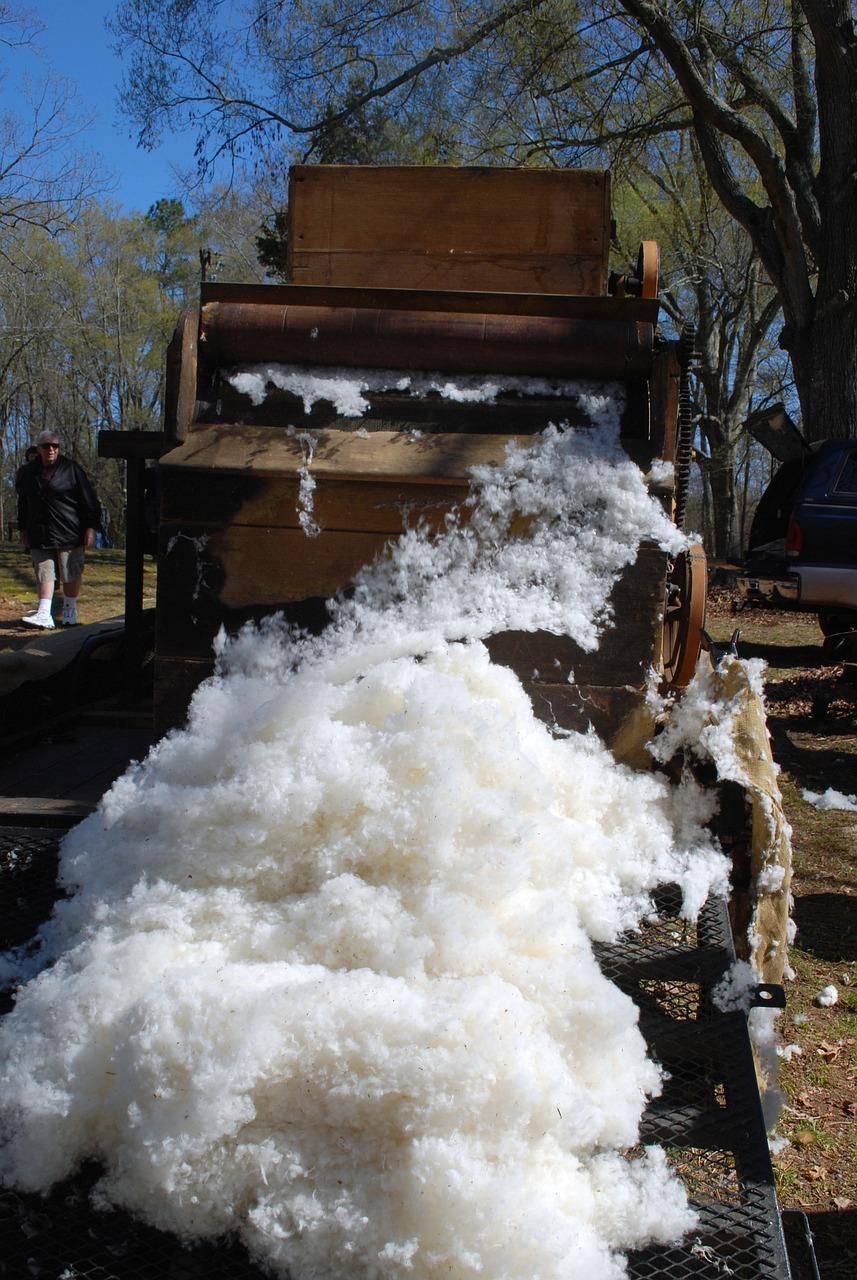The history of the cotton gin is intertwined with the progress and growth of the cotton industry as we know it today. Invented by Eli Whitney in 1793, this mechanical device was a revolutionary step forward in the processing of cotton. It enabled the efficient separation of cotton fibers from their seeds, drastically reducing the time and labor required.
Before the cotton gin, cleaning cotton was an arduous and time-consuming process. Farmers and slaves had to meticulously remove the seeds from the cotton fibers by hand, a task that could take hours or even days for just a small amount of cotton. The invention of the cotton gin brought a paradigm shift, increasing productivity and making cotton a highly profitable agricultural crop.
Throughout the years, the cotton gin has undergone significant changes and improvements, leading to increased efficiency and productivity. From hand-cranked models to steam-powered and eventually electric versions, the cotton gin has evolved to meet the demands of an ever-growing cotton industry. This blog post will explore the transformative impact of the cotton gin, its role in shaping the southern United States, and the pros and cons associated with this influential invention.
So, let’s delve into the intriguing tale of the cotton gin and discover its lasting effects on the cotton industry and society as a whole.

How has the Evolution of the Cotton Gin Revolutionized Cotton Processing
The cotton gin, once a humble hand-cranked machine, has undergone remarkable transformations throughout history, revolutionizing the cotton industry. From its birth in the late 18th century to the present day, the cotton gin has evolved to meet the changing needs of cotton processing. Let’s delve into the captivating journey of this ingenious invention.
The Humble Beginnings of the Cotton Gin
In the late 18th century, an American inventor by the name of Eli Whitney introduced the world to the cotton gin. Or should we say, thegenius gin? This contraption aimed to simplify the labor-intensive process of removing cotton seeds from their fibers. With its simple design, the original cotton gin, powered by a hand crank, was capable of processing far more cotton than any person could in the same amount of time.
The Industrial Revolution Breathes New Life Into the Cotton Gin
As the wheels of progress turned and the Industrial Revolution swept across the United States, the cotton gin embraced change and mechanization. With the advent of steam power in the 19th century, the cotton gin underwent a significant transformation. Steam-powered cotton gins, driven by coal-fed boilers, became a common sight in booming cotton-producing regions. Now, ginners could process vast quantities of cotton with ease, catapulting the cotton industry to new heights.
Electrically Driven Gins in the Modern Era
Fast forward to the 20th century, and new technologies revolutionized the cotton gin once again. The cotton gin transformed from a steam-powered workhorse to an electrified marvel. Electrically driven gins allowed for even greater efficiency, precision, and processing capacity. They eliminated the need for manual operation, freeing up laborers for other tasks. It’s like the cotton gin evolved from a dependable companion to a loyal iron horse!
The Digital Age Transforms Cotton Ginning
In the 21st century, with the digital transformation permeating every aspect of our lives, the cotton gin didn’t stay behind. Modern cotton gins are now equipped with sophisticated digital controls and sensors that optimize performance and reduce waste. These technological advancements actively monitor the entire ginning process, ensuring superior quality and minimizing the environmental impact. It’s incredible how the cotton gin not only got smarter but also greener!
Looking Ahead: The Future of Ginning
As we venture further into the future, it’s plausible to envision even more groundbreaking changes on the horizon for the cotton gin. With the rapid development of artificial intelligence and automation, who knows what innovations lie in store? Perhaps we’ll witness self-driving gins or gins capable of genetically detecting and sorting cotton fibers. The possibilities are as limitless as the cotton fields themselves!
In the journey from a humble hand-cranked machine to a digitized powerhouse, the cotton gin has continuously transformed and revolutionized the cotton processing industry. From its early days of labor-saving ingenuity to the integration of steam power, electricity, and the digital age, the cotton gin has evolved to meet the demands of a changing world. As we step forward into the future, let’s appreciate and celebrate the remarkable journey of this truly transformative invention.

FAQ: How has the cotton gin changed over time
What would happen if the cotton gin was never invented
If the cotton gin was never invented, the process of separating cotton fibers from the seeds would have remained labor-intensive and time-consuming. The lack of an efficient method would have limited cotton production and hindered the growth of the textile industry.
Why was the cotton gin important
The cotton gin was a game-changer in the world of cotton production. It revolutionized the industry by speeding up the process of separating cotton seeds from the fibers. This increased productivity, lowered production costs, and paved the way for the widespread use of cotton in the textile industry.
How did people clean cotton before the cotton gin
Before the cotton gin, cleaning cotton was a manual and painstaking process. Workers had to separate the cotton fibers from the seeds by hand, a process known as “ginning.” This required significant time and labor, making cotton production expensive and inefficient.
How long did it take to clean cotton before the cotton gin
Cleaning cotton before the cotton gin was a slow and laborious task. It could take one person a whole day to clean just one pound of cotton by hand. This meant that large-scale cotton production was impractical and limited to a few regions.
What did the cotton gin replace
The cotton gin replaced the time-consuming handpicking method of separating cotton fibers from seeds. It automated the process, allowing for faster and more efficient production.
Did the cotton gin make cotton cheaper
Yes, the cotton gin made cotton production significantly cheaper. With its invention, the time and labor required to clean cotton reduced dramatically, leading to higher yields and lower costs. This affordability played a vital role in the widespread adoption of cotton by the textile industry.
How did the cotton gin increase productivity
The cotton gin increased productivity by automating the process of separating cotton fibers from the seeds. It could process large quantities of cotton in less time, leading to higher production levels and increased efficiency.
What are the pros and cons of cotton gin
Pros:
- Increased cotton production and availability.
- Lowered production costs, making cotton more affordable.
- Boosted economic growth and profitability for cotton farmers.
- Revolutionized the textile industry and contributed to industrialization.
Cons:
- Reinforced the dependence on slave labor to meet the increasing demand for cotton.
- Contributed to the expansion of plantation farming, leading to environmental degradation and the displacement of indigenous populations.
- Deepened racial inequality and the horrors of slavery.
Was the cotton gin invented by a black man
No, the cotton gin was not invented by a black man. The cotton gin was invented by Eli Whitney, a white American inventor, in 1793. However, the invention of the cotton gin had significant implications for the institution of slavery and the African American community.
What were the positive and negative effects of the cotton gin
The cotton gin had several positive effects, such as increased cotton production, economic growth, and technological innovation. However, it also had negative effects, including the perpetuation of slavery, environmental degradation, and social inequality.
What was the main result of the overproduction of cotton in Texas
The overproduction of cotton in Texas had a profound impact on the state’s economy. It fueled economic growth, attracted immigrants, and played a significant role in the region’s agricultural development. However, it also led to environmental concerns, soil depletion, and economic volatility.
What were the negative effects of the cotton gin
While the cotton gin revolutionized the cotton industry, it also had negative effects. It perpetuated slavery by increasing the demand for labor and reinforcing the institution. Furthermore, the expansion of cotton cultivation contributed to land exhaustion and environmental degradation.
Why would cotton crops be called King Cotton in Texas
Cotton crops in Texas gained the nickname “King Cotton” due to their importance and dominance in the state’s economy. The abundant cotton production made Texas a major player in the cotton industry, earning it the prestigious title of “King.”
What region produced the highest amount of cotton in Texas
In Texas, the region known as the “Blackland Prairie” produced the highest amount of cotton. Its fertile soil, suitable climate, and access to water sources made it an ideal location for cotton cultivation. This region played a pivotal role in cementing Texas’s status as a prominent cotton producer.
What was cotton used for before the cotton gin
Before the cotton gin, cotton had various uses. It was primarily used for making textiles, including clothing, bedding, and household items. Cotton fibers were also employed in the manufacturing of paper, medical supplies, and even explosives.
How did the cotton gin change the South
The cotton gin had a profound impact on the South. It transformed the region into a major cotton-producing powerhouse, driving economic growth and supporting the expansion of plantation farming. The demand for cotton fueled the slave trade and deepened the South’s reliance on enslaved labor.
What best describes the impact of the cotton gin
The cotton gin had a monumental impact on the cotton industry, the economy, and society as a whole. It revolutionized cotton production, increased efficiency, furthered the institution of slavery, and shaped the trajectory of American history. Its effects were wide-ranging and continue to influence our understanding of the past.
